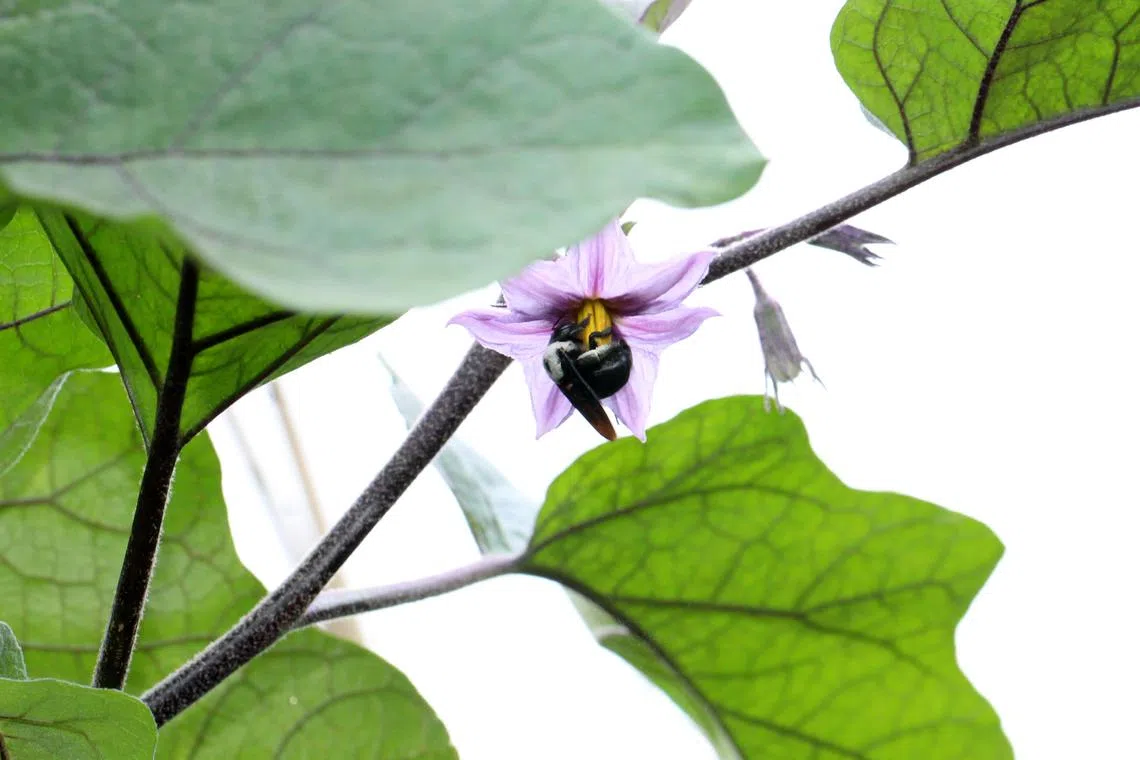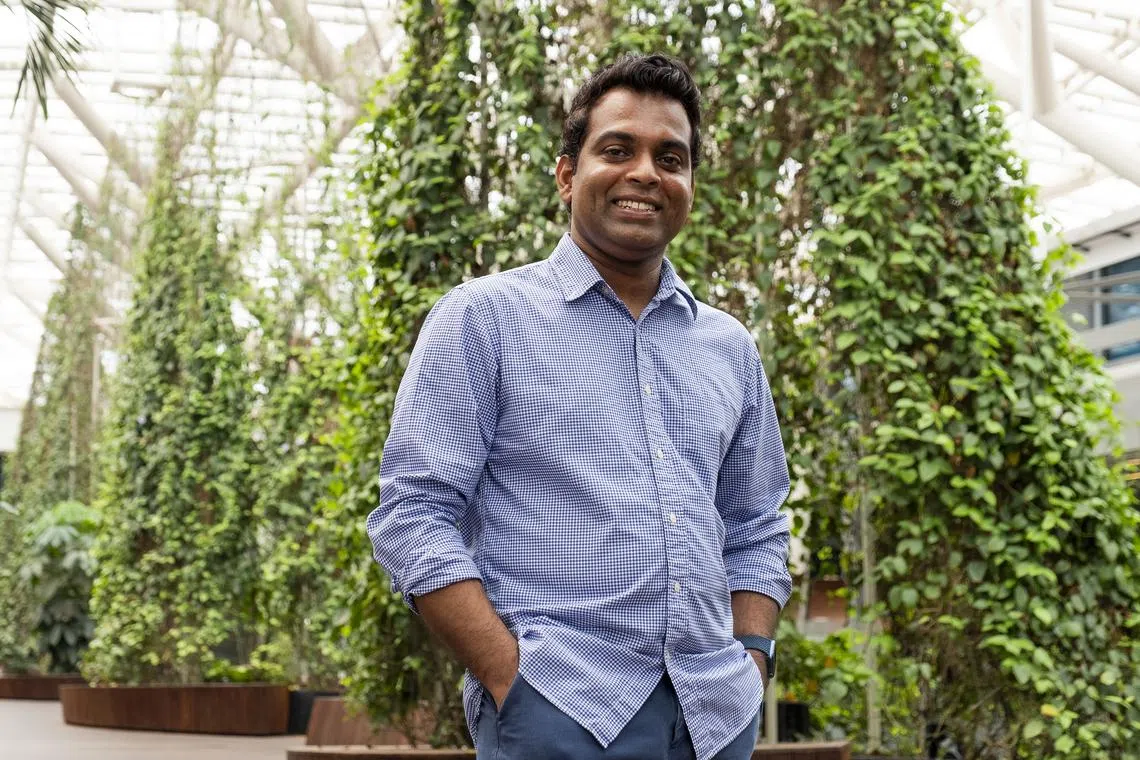Agricultural areas with diverse crops, habitats can help wildlife thrive: Study
Sign up now: Get ST's newsletters delivered to your inbox

The study found that farms with more diversified landscapes can support diverse species of insects, birds and bats.
PHOTO: NTU SINGAPORE
Follow topic:
SINGAPORE – With agricultural lands and livestock paddocks expanding into natural ecosystems, feeding the world can come at the expense of the world’s biodiversity.
But a new study led by researchers at the Nanyang Technological University (NTU) has shown that farms can be more conducive for wildlife. By incorporating a patchwork of crops and semi-natural features into farms, these lands can host thriving ecosystems, they found.
Currently, most farming systems worldwide rely on monocultures, where large areas are dedicated to growing a single crop like wheat or corn. These planting patterns can, however, reduce the types of wildlife found in the area and lead to nutrient depletion of the soil, pest and disease proliferation, and erosion.
One of the largest global studies of its kind, the NTU-led study analysed nearly 6,400 farmlands across 24 countries – 12 per cent of which were in Asian countries such as South Korea and China. It was published in March in the scientific journal Ecology Letters.
The study found that farms with more diversified landscapes, such as those that grow different types of crops, or those that intersperse crop rows with semi-natural features, such as grassy strips, shrubs and wildflower patches, can support diverse species of insects, birds and bats.
This fosters a healthier balance between agriculture and the natural environment, where biodiversity flourishes alongside food production.
The study’s co-author, Associate Professor Eleanor Slade, emphasised the study’s universal value for policymakers, land managers and conservationists.
She said: “By prioritising strategies that enhance crop and landscape diversity, stakeholders can preserve biodiversity and promote sustainable agricultural practices.”
For example, farmlands in Gangwon province, South Korea, reportedly had more wildlife species present when various crops such as potatoes, beans, cabbage and rice were planted alongside semi-natural features. This led to an increase in predators such as beetles and birds, pivotal for controlling pests on farms.
Similarly, in south China, farmlands with smaller fields of sugar cane, corn, rice and vegetables within the same farmland had more pollinators like bees and butterflies.
The study found that if there was greater connectivity between the natural and managed areas of the farmland, birds, bees and other wildlife could move more easily between them. This would improve their access to pollen and other food resources.

A native carpenter bee pollinating an aubergine in a farmland in southern China, where woody semi-natural habitats are present.
PHOTO: NTU SINGAPORE
These positive effects were observed in different types of farmland worldwide, in both tropical and temperate environments, and in farms that plant annual and perennial crops. Annual crops such as corn are harvested annually, while perennial crops such as tomatoes can produce food continuously for years. The benefits were also noted at various spatial scales, from a few hundred metres to several kilometres beyond the farm.
Striking a balance
The benefits of a diversified planting palette on farmland can also extend to farmers.
Previous studies have shown that a larger assemblage of pollinators, such as butterflies, bats and bees, can improve crop yields.
For example, past research had shown that the flying fox, a species of bat, is a crucial pollinator of the durian tree.
The lead author of the NTU study, Mr Tharaka S. Priyadarshana, said this body of research suggests the need to rethink farming practices to improve the environment while safeguarding farmers’ livelihoods.
He noted that there have been other suggestions on how to make farming more environmentally sustainable, such as getting farmers to reduce farming activity or practise organic farming that uses fewer chemicals.
However, he added: “When we look at the practicality of these strategies, they cannot be applied by many farmers because it will affect profit.”
Mr Priyadarshana is a PhD candidate at NTU’s Asian School of the Environment.

The lead author of the NTU study, Mr Tharaka S. Priyadarshana, said this body of research suggests the need to rethink farming practices to improve the environment while safeguarding farmers’ livelihoods.
PHOTO: NTU
While the study focused on farming in rural areas, Mr Priyadarshana noted that such biodiversity-forward ideas can be incorporated into urban farming, such as vertical farming and community gardens.
These include intercropping, where multiple crops are planted together, and layered planting, where vertical farms grow plants on multiple levels.
Said Mr Priyadarshana: “Agricultural systems are often managed to maximise their production in the economic sense. But by adapting farming practices and rethinking the way we integrate crop and non-crop habitats, they can also be managed to minimise environmental issues and maximise important services like pollination and pest control that boost crop production.”
Global recognition
The latest study comes amid a growing recognition of the need to change practices with negative implications for nature, to stop biodiversity decline.
In December 2022, 196 countries agreed on the new Global Biodiversity Framework that aimed to halt and reverse nature loss. Other initiatives, such as the Taskforce on Nature-related Financial Disclosures, are also nudging companies to recognise the need to integrate biodiversity considerations into business decisions.
Society’s well-being depends on nature – 55 per cent of the global gross domestic product, equivalent to US$58 trillion (S$78.6 trillion), is dependent on nature, professional services firm PwC found in 2023. In 2018, the World Wildlife Fund, an environmental group, also reported that the global valuation of ecosystem services is at least US$125 trillion every year.
But nature’s decline could jeopardise these services.
The UN Food and Agriculture Organisation reported that the loss of biodiversity, which is already in decline, threatens the security of the world’s food supplies and the livelihoods of millions.
Three agricultural businesses approached by The Straits Times – Nestle, Unilever and Olam – said they are aware of the importance of biodiversity in farming, and that biodiversity is fundamental for ecosystem balance and soil health.
Yet, there are social considerations involved in encouraging farmers to diversify their crops and landscapes.
Both Unilever and Nestle, which produce consumer goods such as ice cream and coffee, highlighted the steep learning curve for farmers adopting sustainable practices.
A Unilever spokesperson said using a diverse cropping system involves gaining extensive knowledge on such practices and making specific technical adjustments suited to local conditions, while also being able to maintain these farming techniques sustainably – a complex process, which “requires careful management at the onset”.
Despite this, the agri-firms said they try to promote farming practices beneficial for wildlife and smallholder farmers albeit in other ways.
Among these efforts is Nestle’s provision of weather insurance for over 800 coffee farmers in Indonesia to help them cope with unpredictable weather patterns of rainfall and severe drought.
This ensures the farmers have a stable income despite the climate challenges, and allows farmers to invest in sustainable farming practices without the immediate pressure of financial insecurity.
Unilever said it plans to enrol 250,000 smallholder farmers into “livelihood programmes” – such as vocational training – by 2026. These programmes are aligned with Unilever’s Sustainable Agriculture Code, said its spokesperson.
This will equip farmers with the knowledge and skills necessary to adopt sustainable and productive agricultural practices, and facilitate access to new markets where consumers are more conscious about buying from sustainable sources, Unilever said.
A spokesperson for Singapore-based agriculture firm Olam Group said it encourages farming partners in Thailand and Vietnam to use ducks to control the population of molluscs in rice farms, instead of using molluscicide, which can be harmful to other organisms.
To encourage farmers to adopt wildlife-friendly practices, Olam shared that support like “tools and training” are provided to minimise the environmental impact of agriculture. It is one of the first Singapore-based companies that have committed to voluntarily offering nature-related financial disclosures by financial year 2025.
At present, Olam Group has trained more than 530,000 farmers globally to enable them to grow more on less land and incentivise more environmentally sound practices, such as non-pesticide pest management methods. “This two-pronged approach offers sustainable alternatives that protect and restore forests in crucial landscapes,” the Olam spokesperson added.
Mr Priyadarshana underscored that, in the long term, to implement any conservation strategies within farmlands, farmers must be assured that these strategies will not adversely affect their profits.
Raising consumer awareness, for one thing, can mark a pivotal step towards fostering a more sustainable global food system.
“Increasing consumer awareness and demand for sustainably produced food can create market opportunities for farmers who adopt sustainable practices,” said Mr Priyadarshana.

